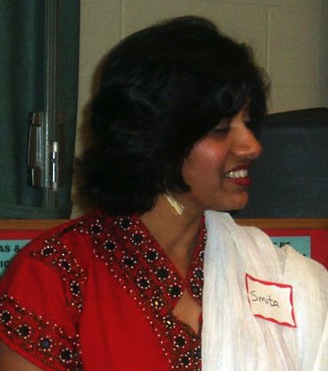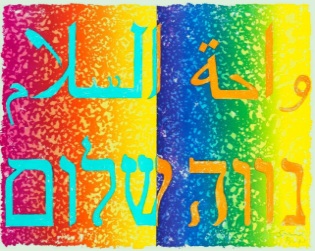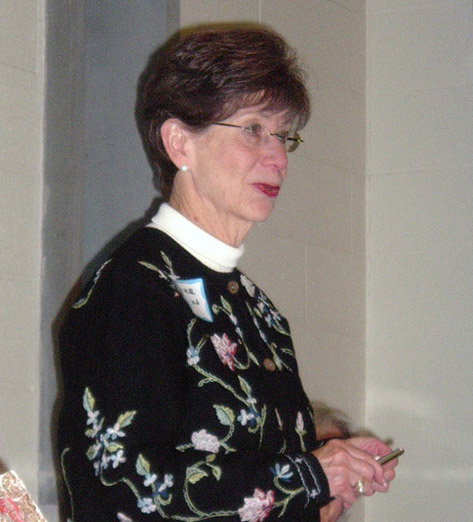
Smita Rane, a native of India, one of the countries affected by the tsunami, lit a multi-flame lamp as the group observed a moment of silence for the tsunami victims. Smita also shared with us a large pictorial display she had created of the tsunami’s devastation. Barbara Fought and Bonnie Shoultz explained that WTB has donated a tithe (ten percent) of its treasury ($250) for tsunami relief via UNICEF, and anonymous donors have given $1000. Members were invited to contribute, although many have already done so through other groups. These donations altogether netted $1775, which we will send to UNICEF.
Mara Sapon-Shevin led a community-building exercise asking women to reflect quietly and imagine what peace in the Middle East would look like. We separated into small groups to share our visions of peace. Then, with all of us rejoined into one large group, 12 women stood and called out a phrase to create a kind of peace poem. Nancy Sullivan Murray introduced the panel.
Gobind Sadan—Jean Polly and Sara Farchione

Gobind Sadan was founded in Delhi by Baba Virsa Singh ji (Babaji), a holy man in India who believes that “God has no religion and no country.” Although Gobind Sadan is based on a Sikh tradition, it is an intentional community where people of all faiths can gather to celebrate each other’s holidays and religious festivals. Babaji believes that all prophets came from the same light with the same message, and that sectarian religious divisions occurred later. On the grounds of Gobind Sadan, one finds statues to various prophets, including Jesus. There are a mosque and a menorah; there are many Hindu shrines. Gobind Sadan is a place where people come together to pray for peace, with round-the-clock devotions at the havans, or sacred fires. Babaji teaches that “God is sitting inside you, nearer than your hands and feet. The distance between you and God is as thin as an insect’s wing.”
Babaji took land that no one else could farm. He talks to his plants and asks them what they want. His farms have thrived so much that scientists from all over the world, including some from Cornell University, have come to study them. These farms sustain Gobind Sadan, which is a devotional center. No donations are requested. All that is asked is for visitors to love God. Out of the farms’ surpluses, people in the community are fed, with all castes sitting side by side. There are free medical care and a free children’s school.
The town hall on the grounds is an educational institute for comparative religions. Sara traveled there last February to attend an international conference on righteous work in the service of God and others. Also present at the conference were people from all over the world and from many different traditions and professions. The panelists talked about their own faith scripture, most of them emphasizing that the important thing is not what your hands are doing; if your mind is on God, then your work is service. Sara reported a real sense of peace and joy.
Jean and Sara also talked about Gobind Sadan USA, north of Syracuse in Central Square. They showed some fragments of prayer cloths that survived the 2001 fire that was set by several youths who, when drunk, mistook the words “Gobind Sadan” for “Go Bin Laden.” Miraculously, even though the fire destroyed the building where it was enshrined, the sacred Sikh scripture, the Guru Granth Sahib, escaped unharmed. The Guru Granth Sahib is wrapped in beautiful cloths and placed on soft pillows under a canopy. Two professors from the Newhouse School created a movie about the fire. Titled North of 49, it is available on DVD.
Neve Shalom/Wahat al-Salam—Elaine Rubenstein

Neve Shalom/Wahat al-Salam, which means “Oasis of Peace” in Hebrew and Arabic, respectively, is an everyday living community of about 53 families, comprising a virtually equal number of Israeli Jews and Israeli Palestinians. Founded in 1978, it is located between Jerusalem and Tel Aviv. The community has the facilities needed for its members’ lifestyle. It also has the first intercultural, bilingual school in Israel, a school that has become a model for all Israeli schools, which are now tending to be bilingual. Begun at the nursery and primary levels, it has expanded to include a junior high school. The community has a guest house where families can come for vacation or where groups can stay for educational purposes. It also has a totally nondenominational spiritual center.
The business of Neve Shalom/Wahat al-Salam is its School for Peace, which brings together Arab and Jewish teenagers as well as teenagers from other countries. The School for Peace’s syllabus was partially funded by the Ford Foundation and is an organized way for students to dialogue and role play. The School for Peace has fostered dialogue among hundreds of thousands of students and is a model for schools in other countries. Its faculty members have acted as consultants to other schools, including schools in Los Angeles dealing with problems stemming from racism.

Elaine remembers visiting the first Jewish and Palestinian families who moved to Neve Shalom/Wahat al-Salam, located in a then very desolate area. The families had nothing, not even plumbing, but they were idealistic and put their lives where their hearts were. They sought first to understand, then to be understood. They learned about each other’s holidays and celebrated them together. They developed a beautiful democracy, which has had political problems, as all democracies do.
One of the greatest problems that has developed over the years stems from the fact that the community’s Jewish teenagers must serve in the Israeli military. Sadly, one of these teens was killed. This created a very difficult situation in the community, first because the Jewish boys do not want to be in the army fighting the relatives of their friends, and second because the slain soldier was one of their own. The people of the community reached out and supported one another in their grief. The community’s proximity to the West Bank also leaves it very vulnerable to violence; at times, the members must board up their windows for protection.
Elaine, who is a member of the Syracuse Area Middle East Dialogue (SAMED), said that there is always hope; and with the Palestinian Authority elections going on today, there is renewed optimism. Elaine wants the United States to support every effort toward peace. Just as the schools in Neve Shalom/Wahat al-Salam are models for other schools, the community itself offers hope for peace. Elaine hosts community members who come to Syracuse to share their story, and she hopes that WTB members will be able to attend one of their future presentations.
Israeli/Palestinian Situation—Sultana Musa
Sultana is a Palestinian whose family was evicted from their home in 1948. She wants us to understand that the history of the partition of the country started long before that. Late in the 19th century, the Zionist movement in Europe began talking about a Jewish homeland because the Jewish people were scattered all over the world. They had in mind two countries at the time, Argentina and Palestine. In 1897, the Zionists, led by Theodore Herzl, met in Switzerland and decided on Palestine. They sent a delegation to visit Palestine and received a cable back from them: “The bride is beautiful, but she is married to another man.” Palestine, at that time, was a province of the Ottoman Empire. Zionist leaders wanted to work with the Sultan of the Ottoman Empire, but the Sultan refused to let the Jews come to Palestine.
By 1917, Palestine was under a British mandate. The British, in the Balfour Declaration (named after Britain’s foreign minister), told Zionist leaders that they could have a small area of Palestine. By 1922, Jewish immigration had far exceeded the limits set by the Balfour Declaration. Winston Churchill was upset over the immigration and wrote a White Paper that limited Jewish immigration and excluded Trans-Jordan from receiving the immigrants. The Palestinians revolted between 1936 and 1939. In 1942, the American Zionist Movement met at the Biltmore Hotel in New York City and, for the first time, talked openly about a Jewish state in Palestine that they hoped would include all the land there. In 1945, the British sought help from the United States regarding the partition of Palestine. In 1946, the question of partition went to the United Nations, which the next year issued Resolution 181 agreeing to the partition of Palestine. On May 14, 1948, the partition took effect, with 52 percent of the land going to the State of Israel and 48 percent to the Palestinians. The first two countries to vote for the partition were the US and the USSR; Britain abstained. The Palestinians were upset because overnight they had lost more than half their land; the Jews were upset because they had wanted all the land for a homeland. By 1967, Sultana said, Israel was in possession of the rest of the land.
Sultana explained that the continuing Jewish settlements and the security wall have been very upsetting to the Palestinians. There are 250 miles of roads in the West Bank that the Palestinians are not allowed to use. There are 700 checkpoints that the Palestinians must go through, often making it almost impossible for them to get to their jobs, schools, hospitals, and even their own olive groves and fields. They cannot control the source of their water. Sultana said that the Palestinians want freedom, they want justice, they want to go to good schools, they want good jobs, and they want to be able to get to their water and their farms. The wall, constructed by the Israeli government on land owned by the Palestinians, has iron gates, which often are closed before the Palestinians can reach them.
Both the Jews and the Palestinians want the whole country, Sultana stated. It must be understood that both are there to stay. Both really want to live in peace, but peace will never come by the sword. Before the existence of the Jewish state, there were Jews, Christians and Muslims living together in peace, so Sultana knows it can be done. In order to have peace, both sides have to work together, and there must be justice and freedom for all. Peace is a joint effort. Without peace, there can be no security. It is Sultana’s hope that one day both sides will work together and live together in peace.
Sharing
There was a question-and-comment period after the presentations, with much appreciation expressed to the speakers. The meeting ended with Linda Bergh spontaneously leading everyone in a song that expressed all our hopes that, “Every one ‘neath their vine and fig tree shall live in peace and unafraid.”
